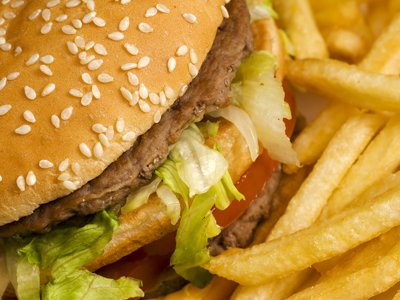Periodically, the media jumps on a story about efforts the fast food industry professes to be making to provide healthier options to patrons. Through the years, some of these have included touting lower-fat items, more salads, fresh fruit desserts, and grilled chicken choices. But did you ever wonder whether these improvements actually make any substantial sort of nutritional difference? If so, you aren’t the only one. A team of researchers just performed an analysis of the nutrition content of fast food items across nearly two decades and discovered things really haven’t improved much at all.
The study, which took place at the Friedman School of Nutrition Science and Policy at Tufts University in Boston, Massachusetts, found that there was little difference from 1996 through 2013 in most of the nutritional aspects evaluated, which included calories, saturated fat, and salt content.1 Mundell, E.J. “Is fast food getting any healthier?” CBS News. 1 January 2015. Accessed 7 January 2015. http://www.cbsnews.com/news/is-fast-food-getting-healthier The comparisons were conducted on menu items at three major, but unnamed, fast food chains.
The scientists focused on four fast food staples: cheeseburgers, French fries, grilled chicken sandwiches, and cola drinks. They then expanded their analysis to include both two-ounce and four-ounce sizes of cheeseburgers and small, medium, and large sizes of fries and colas as well as the standard chicken sandwich, for a total of 27 foods.
Sadly, the average number of calories and levels of salt and saturated fat did not discernibly change between 1996 and 2013. And this would be enough of a problem if only one menu item was typically consumed at a time. However, most people order several items together and the restaurants provide financial incentives with “meal deals” that bundle the burger or chicken with fries and a soda. The combination causes not only the consumer’s caloric intake to skyrocket, but also drives sodium levels into the stratosphere.
The scientists found that the combination of a 4-ounce cheeseburger with fries and a soda–a common fast food meal–contained anywhere from 1,144 to 1,757 calories at the three chains, without much variation through the 17-year period. This one meal can provide a person with 91 percent of their recommended daily intake of sodium and blows a substantial portion of the 2,000 calories recommended for the day. Since most people are likely not skimping on their other meals or even skipping snacks, it’s easy to see how quickly caloric intake rises tremendously and weight is gained.
There were at least a couple of pieces of good news in the findings. The levels of trans fats in the fast food French fries were considerably lower in the later years of the research than the earlier years, with a particularly big drop between 2005 and 2009. This may be due to FDA regulations requiring restaurants to list the amount of trans fats in a food, which resulted in the chains switching to different oils for frying that contain far fewer trans fats. Synthetic trans fats are known to raise LDL cholesterol levels and increase the risk of cardiovascular disease.
The findings also showed that fast food chains have not altered their portion sizes much throughout the study period. While there very well may be super-size options available to those who want even more food, the standard offerings remained roughly the same. Of course, this is still not wonderful given the total calorie, fat, and sodium content of the foods, but at least they haven’t gotten even larger and higher in these totals.
Oh, and as for those salad and fruit choices, people do order them–just not very often. But really, how many people do you think go to a McDonalds for a salad versus the number who go for one of their burger options?
The takeaway from this study is that no matter how great the fast food chains’ marketing gurus claim their improvements are, the vast majority of their menu items are just not nutritionally smart choices. If you have to eat fast food once in a great while for convenience, it isn’t going to impact you too badly. The trouble is, most people eat it a lot more frequently than that. In fact, a 2013 study at the Centers for Disease Control and Prevention in Atlanta found that an astounding 11.3 percent of the average adult’s daily caloric intake is derived from fast food.2 Fryar, Cheryl D. and Ervin, R. Bethene. “Caloric Intake From Fast Food Among Adults: United States, 2007-2010.” Centers for Disease Control and Prevention. February 2013. Accessed 8 January 2015. http://www.cdc.gov/nchs/data/databriefs/db114.pdf
If fast food is a guilty pleasure of yours, try to wean yourself off of it. Consider the options when you’re inclined to turn to fast food. Is it for a quick, inexpensive lunch while you’re running errands? Make a healthy salad or lean turkey wrap the night before instead. Is it because you’re too hungry to cook by the time you’re finished with afternoon activities? Try bringing a nutritious snack such as fruit slices or trail mix to hold you over until you’re home and are ready to make dinner. You may be surprised at how quickly you start seeing a difference from cutting out the extra calories and sodium bloat, which just might motivate you to do even more to get healthier.
References
| ↑1 | Mundell, E.J. “Is fast food getting any healthier?” CBS News. 1 January 2015. Accessed 7 January 2015. http://www.cbsnews.com/news/is-fast-food-getting-healthier |
|---|---|
| ↑2 | Fryar, Cheryl D. and Ervin, R. Bethene. “Caloric Intake From Fast Food Among Adults: United States, 2007-2010.” Centers for Disease Control and Prevention. February 2013. Accessed 8 January 2015. http://www.cdc.gov/nchs/data/databriefs/db114.pdf |











